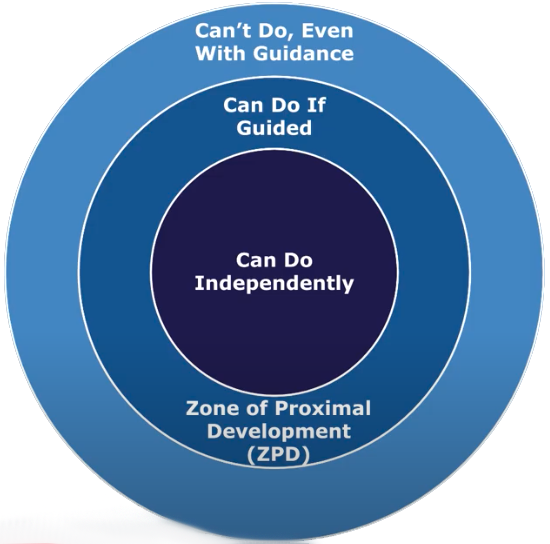Slow down in order to go quickly!!!
(source: https://focusresourcesinc.com/wp-content/uploads/2015/01/tortoise-hare.jpg)
As topic 3 unfolded in our PBL group, it became quite clear that collaboration entails many aspects of learning. To view our flowerbed using the Lotus Blossom approach, please visit this SITE. As my interests lay in scaffolding, I decided to create a blog post about it.
Most literature on scaffolding will warn you about the misconceptions between scaffolding and differentiation [1]. Differentiation in learning refers to the approaches in which students receive different methods of instruction depending on the instructor's perception of the aptitude of each of his students. Scaffolding, on the other hand, refers to approaches that break up learning into chunks so that students can tackle increasingly more complex material.
The Zone
Lev Vygotsky proposed the Zone of Proximal Development and this has been the basis for scaffolding.
(source: https://www.letsgolearn.com/wp-content/uploads/2020/08/Zone-of-Proximal-Development-diagram.png)Benefits[3][4]
The references provide many benefits of scaffolding in learning. I will highlight a couple of these benefits that I believe to be instrumental in adopting scaffolding in our teaching.
1. Enhanced Problem Solving Skills. Implementing scaffolding takes time and requires the instructor to truly take stock of his/her students' learning abilities. If properly executed, students will be able to connect the lessons learnt in the past to the scaffolded lesson. Students will also treat all past lessons as building blocks to learn newer and challenging lessons. With such a strong foundation, we can expect students to exhibit much enhanced problem solving skills.
2. Motivates
learners to become better students. Through scaffolding, students begin to appreciate breaking problems into smaller chunks, often based on past lessons. When this practice becomes habitual, students become more independent in their learning and with this comes increased confidence. Independence and confidence are obvious traits of better students.
Challenges[5]
Many challenges exist in implementing scaffolding for learning. Of these, in my opinion, the following two are the most critical for the success of scaffolding.
1. Proper Training and Experience. Scaffolding is best described as an art, rather than a science. Training or understudying experts are important. Furthermore, Scaffolding is a skill that needs to be honed and practiced.
2. Misjudging the Zone of Proximal Development. The Zone of Proximal Development is the basis for scaffolding. Misjudging it can have profound consequences. As stated earlier (see "The Zone" above), providing scaffolding outside of the ZPD can lead to unnecessary or ineffective scaffolding.
Strategies[6]
(source: https://www.slideshare.net/abc_555/6-scaffolding-strategies-to-use-with-your-students)
These six strategies are often used in creating scaffolds for teaching various disciplines. Naturally, these six strategies are classified under disciplined appropriate categories. The strategic flow is as follows: 1. Show the students the actual or working model of the subject to be learned. 2. Emphasize prior lessons that are the foundations of the current lesson. 3. Provide ample time for students to discuss and ask questions. 4. Provide and explain the necessary vocabulary (terms and definitions) for the lesson. 5. Use visual aids to explain/describe the subject. 6. Allow time for students to digest the lesson and then ask questions and subsequently review the lesson after another sufficient pause.
Scaffolding in Engineering Curriculum[7][8]
My livelihood and interests lie in Engineering Education. For those who share a similar interests as me, I was able to find these two references that discuss scaffolding in engineering education.
Relevance of the title of this post[6]
Scaffolding a lesson will be time consuming. Identifying the necessary scaffolds for students will also be arduous. Nevertheless, the end product of such an endeavor will be of high quality and the foundation of the resulting learning will be very strong. Hence, it makes sense to "slow down in order to go quickly" subsequently. Such an approach may also expand the Zone of Proximal Development.
References
A. West, J. Swanson; and L. Lipscomb, "Ch. 11 Scaffolding" in "Instructional Methods, Strategies and Technologies to Meet the Needs of All Learners." An e-book.
R. Alber, "6 Scaffolding Strategies to Use With Your Students"
P.C. Boylan-Ashraf, S.A. Freeman, and M.C. Shelley, Scaffolding in Introductory Engineering Courses, Journal of STEM Education, Vol. 16, No. 4, 2015.
M. M. Girgis, A Scaffolding Case Study for Teaching Engineering Problem Solving to Under represented Minorities, 122nd ASEE Annual Conference and Exposition, Seattle, WA, 2015. (Paper ID #14124)



Comments
Post a Comment